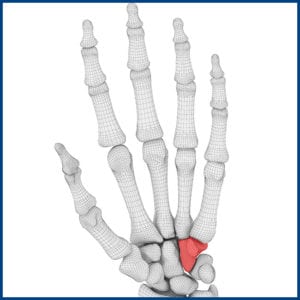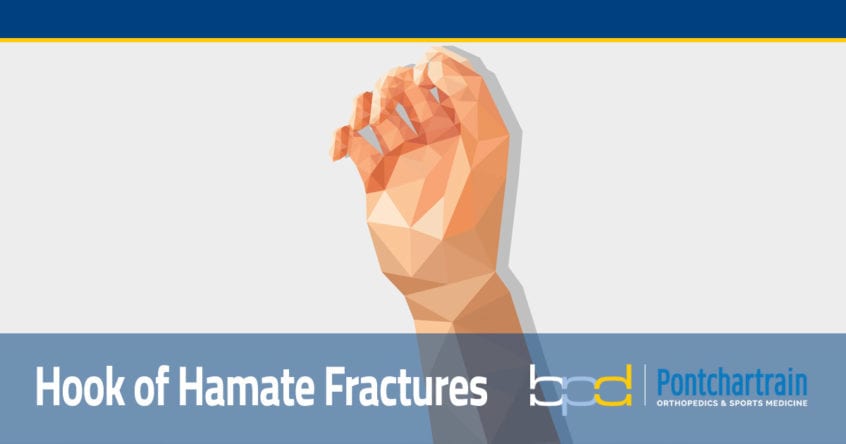What is the Hook of Hamate?

The hamate bone is one of eight small carpal bones located in the wrist. The hamate is the wedge-shaped bone located on the outside or pinky side of the wrist. In describing the bone, we discuss two areas: the body and the hook. The projection on the front or palm side of the bone is called "the Hook of Hamate." The hook borders the pinky side of the carpal tunnel Guyon canal where the ulna nerve runs in the hand.
What are Hook of Hamate Fractures?
There are two main types of fractures to the hamate. One involving the body, and a second involving this hook projection, which we will discuss further. Hook of hamate fractures are more common than hamate body fractures accounting for 2-4% of all wrist bone fractures, with the scaphoid being most commonly injured with incidence of 60% of all carpal bone fractures. They are twice as common to occur in males, and often seen in athletes participating in gripping sports (golf, baseball, hockey).
Symptoms of hook fractures include:
What Causes Hook of Hamate Fractures?
How is this Fracture Diagnosed?
Hook of Hamate fractures are diagnosed through physical examinations and x-rays. Standard x-rays for wrist injuries usually do not show this fracture and require a special view referred to as a carpal tunnel view. A physician may place pressure on the wrist to pinpoint the location of the injury. Because this is usually not seen on the standard imaging, there is often a delay in diagnosis (averaging 4 weeks).
Clinical suspicion aids in the diagnosis. If a fracture is suspected with negative radiographs, advanced imaging with CT or MRI scans may be obtained.
Treatment Options
Treatment of Hook of Hamate fractures depends on the severity of the fracture.
Nonsurgical
Non-displaced fractures (fractures where the fractured bone remains in place) may be treated through nonsurgical methods. Nonsurgical treatment consists of immobilization in a brace, splint, or cast for upwards of 6 weeks. Despite immobilization, a large number of Hook of Hamate fractures go on to a nonunion, which means they do not heal. This occurs in 40-50% of cases. Fortunately, a majority of these patients are pain free and full motion.
Surgical
Surgical treatment may be necessary to treat some Hook of the Hamate fractures. This is indicated in displaced fractures, fractures that cause nerve irritation, or in high level athletes.
Surgery is also the treatment of choice for a symptomatic nonunion, that is a fracture that did not heal and continued to be painful.
The typical surgical procedure for Hook of Hamate fractures and nonunions involves removing the fractured or non-united “hook”. Although rarely, standard fracture fixation with screws may be performed to fix the fracture.
Recovery Time
Nonsurgically treated fractures usually heal within about six to eight weeks of immobilization followed by several weeks working on motion and strength.
Surgical treatment recovery varies. When looking at this injury in professional baseball players, return to play can be as soon as 3 weeks but full recovery averaged around 7 weeks.

